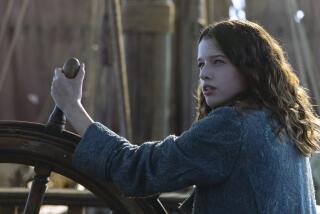Sometimes It Takes a Woman to Do a Boy’s Job
- Share via
To many, Mary Martin is still the quintessential Peter Pan. Sandy Duncan won fans for her impish, surprisingly gutsy stage portrayal, however, and Cathy Rigby is downright astonishing.
Actresses of the early 20th century were also lauded when they played the part of “The Boy Who Would Not Grow Up.”
So why has it so often taken a woman to do a boy’s job? Why have audiences been required to suspend disbelief and accept a woman in boy’s clothing--one who fights off pirates and plays house with Wendy in Neverland no less?
It began with the very first Peter Pan, Nina Boucicault, who opened in the 1904 premiere of J.M. Barrie’s play in London. It was part of British pantomime tradition to have a woman play “principal boy.” And Barrie’s multilayered fantasy in particular would require someone mature enough to convey emotional subtleties.
Boucicault, a serious stage actress who had done Barrie’s “Little Mary” in 1903, was a hit, as was the play. Then, acclaimed American stage actress Maude Adams triumphed in the role when the play made its way across the Atlantic to the United States in 1905. Another American, Pauline Chase, began playing the part in London in 1906.
The tradition continued as the century grew older. Among other women cast were silent film actress Betty Bronson, who starred in the first film version in 1924; noted stage actress-director Eva Le Gallienne; (1928) and Hollywood star Jean Arthur (1950).
And then came Mary Martin and the 1954 musical smash staged by Jerome Robbins, with music and songs by Mark Charlap, Carolyn Leigh, Jule Styne, Betty Comden and Adolph Green. Martin soon not only owned the role on stage, she also made it her own on television. Her version aired three times, twice live and again in 1960, in the videotaped version that would come to define Barrie’s classic for millions.
Yet times change. Although a male Peter Pan is by no means unprecedented, the role has traditionally remained women’s territory. Steven Spielberg’s film “Hook,” with Robin Williams as an adult Peter Pan notwithstanding, it is across the Atlantic--where this gender-bending started--that tradition has been broken.
In 1982, the Royal Shakespeare Company defied expectations with its shiny new production of Barrie’s classic, adapted by Trevor Nunn and John Caird and starring 35-year-old actor Miles Anderson as Peter. It was a resounding success.
The Royal National Theatre continued the trend with a new version of the Nunn-Caird adaptation earlier this year. With actor Daniel Evans as Peter (and Sir Ian McKellen as Hook), it triumphed again.
More to Read
Only good movies
Get the Indie Focus newsletter, Mark Olsen's weekly guide to the world of cinema.
You may occasionally receive promotional content from the Los Angeles Times.










